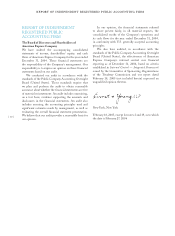American Express 2006 Annual Report Download - page 78
Download and view the complete annual report
Please find page 78 of the 2006 American Express annual report below. You can navigate through the pages in the report by either clicking on the pages listed below, or by using the keyword search tool below to find specific information within the annual report. [ 76 ]
notes to consolidated fi nancial statements
american express company
revenues are recognized at the time a ticket is purchased.
Other travel suppliers that pay commissions on hotels
and car rentals generally are not under firm contractual
agreements, and, therefore, revenue is not recognized
until cash is received.
Other commissions and fees
Other commissions and fees include foreign exchange
conversion fees and other card-related assessments,
which are recognized primarily in the period in which
they are charged to the cardmember. Fees related to
the Company’s Membership Rewards program are
deferred and recognized over the period covered by the
fee and included in deferred card fees, net of deferred
acquisition costs.
Securitization income, net
Net securitization income includes non-credit provision
components of the net gains and charges from
securitization activities; impairment charges, if any,
of the related interest-only strip; excess spread related
to securitized cardmember loans; net finance charge
revenue on retained interests in securitized cardmember
loans; and servicing income, net of related discounts or
fees. Excess spread is the net positive cash flow from
interest and fee collections allocated to the third-party
investors’ interests in the securitization after deducting
the interest paid on the investor certificates, credit losses,
contractual servicing fees and other expenses. Excess
spread is recognized as it is earned.
Other investment and interest income, net of interest
Investment and interest income for the Company’s
performing fixed-income securities is accrued as earned
using the effective interest method, which adjusts the
yield for security premiums and discounts, fees and
other payments, so that the related security recognizes
a constant rate of return on the outstanding balance
throughout its term. The Company also accrues
investment income using the straight-line method for
a certain investment portfolio. The difference between
the straight-line and the effective interest method for
this portfolio was not significant.
Interest income for the Company’s international
banking and other loans is accrued on unpaid principal
balances using the effective interest method unless
collection of interest is in doubt. In those cases, interest
income is recognized only to the extent it is received in
cash. Generally, the accrual of interest on these loans and
advances is discontinued if a loan is 90 days delinquent
(depending on loan type) or when an impairment is
determined. When management doubts outstanding
balances will be paid in full, all cash received is applied
to reduce the carrying value of the loan or advance. Fees
are deferred and amortized over the life of the loan or
advance using the effective interest method.
Other investment income and interest income
is presented net of interest expense of $420 million,
$321 million, and $220 million for 2006, 2005, and
2004, respectively, related primarily to the Company’s
international banking operations.
Contra-revenue
The Company regularly makes payments to its customers
through a variety of arrangements, including both cash
and non-cash awards to cardmembers in conjunction
with loyalty programs such as Membership Rewards,
as well as through other contractual arrangements with
merchants, Corporate Card Clients and other customers.
Cash payments to customers are classified as contra-
revenue unless management can identify a specifically
identifiable benefit (e.g., goods or services) received by the
Company in consideration for that payment. If no such
benefit is identified, then the entire payment is classified
as contra-revenue. If such a benefit is identified, then
the payment is classified as expense up to the estimated
fair value of the benefit. Non-cash payments, such as
Membership Rewards points earned and redeemed by
cardmembers and those stored value products provided
to cardmembers that cannot be redeemed for cash, are
classified as expenses along with cash payments to co-
brand partners for the participation of the Company’s
cardmembers in the partners’ reward programs.
Other revenue
Other revenue includes insurance premiums earned
from cardmember travel and other insurance programs,
publishing revenues, and other miscellaneous revenue
and fees.
EXPENSES
Stock-based compensation
Effective July 1, 2005, the Company adopted SFAS No.
123 (revised 2004), “Share-Based Payment” (SFAS No.
123(R)), using the modified prospective application.
The adoption of SFAS No. 123(R) requires entities to
measure and recognize the cost of employee services
received in exchange for an award of equity instruments
based on the grant-date fair value of the award. The
adoption of SFAS No. 123(R) did not materially impact
the Company’s Consolidated Financial Statements
since the Company has been expensing share-based
awards granted after January 1, 2003, under the
provisions of SFAS No. 123, “Accounting for Stock-
























